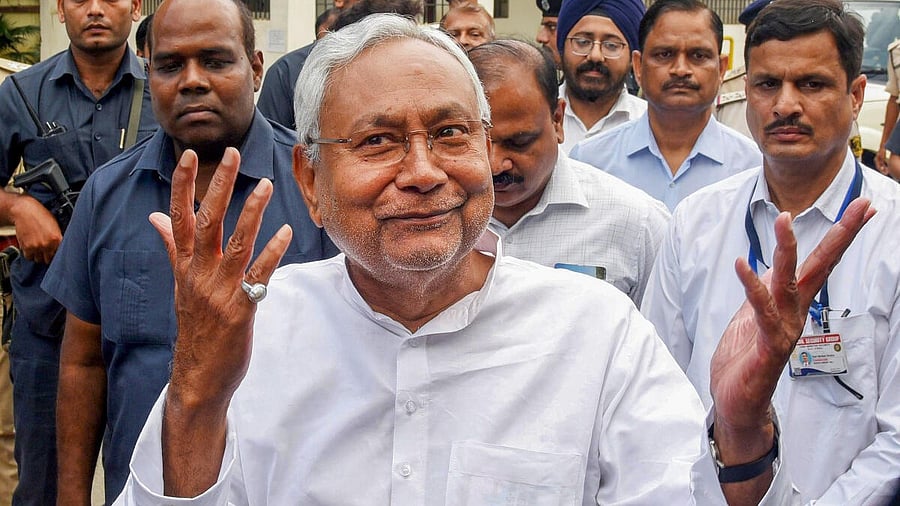
Bihar Chief Minister Nitish Kumar.
Credit: PTI
On Gandhi Jayanti, Bihar Chief Minister Nitish Kumar threw a googly at settled equations in north Indian politics when he tweeted that the caste census undertaken by the state has been released. Deputy Chief Minister Tejashwi Yadav, son of RJD founder Lalu Prasad who is arguably the original face of subaltern politics, declared that history had been made — despite the Bharatiya Janata Party (BJP)’s attempts to scuttle this exercise.
Briefly, the data shows that 27.13 per cent of Bihar’s population falls in the category called Other Backward Classes (OBCs) while 36 per cent are Extremely Backward Classes (EBCs). The OBC and the EBC categories add up to 63 per cent while the reservation in government jobs and educational institutions for them stands at 27 per cent.
The Dalits constitute 19.65 per cent of the population, and the Scheduled Tribes make up 1.68 per cent.
The general category, which includes all the upper castes, stands at 15.5 per cent of the population who can currently compete for 50 per cent of the job openings and opportunities in educational institutions. One can predict the slogan: 50 per cent for 15 per cent! This is a political hot potato that makes the Bharatiya Janata Party (BJP) uncomfortable as all the data shows that their support is greatest among the upper castes although they also have bases among sections of the backward castes and the Dalits.
The real clash is political, but also between the civilisational project of the BJP/Rashtriya Swayamsevak Sangh (RSS) and that of the Mandal era socialist parties, two of which are in a coalition in Bihar. The interesting addition to the positioning in recent months is the Congress, led by its president Mallikarjun Kharge and former president Rahul Gandhi that has also put its might behind messaging about social justice. Rahul Gandhi’s speech in Parliament during the debate on the Women’s Reservation Bill consisted of reading out data that showed the top bureaucracy as coming from the privileged castes and demanding reservation within the women’s quota.
It is a case of history coming full circle as the Congress had lost its grip over Uttar Pradesh and Bihar largely because its state leadership was dominated by the upper castes and, thereby, not representative. The BJP of that era, conversely, projected several OBC leaders as it made its mark in Indian politics in the age where settled equations had been upset by the power of Mandal. Some of its Ram temple movement mascots came from the backward classes such as Uma Bharati, briefly Chief Minister of Madhya Pradesh, while Kalyan Singh was Uttar Pradesh Chief Minister when the Babri mosque was demolished.
RSS ideologues such as K Govindacharya, fiercely committed to the civilisational project, frequently expanded in those days on the need for ‘social engineering’ to an end. But it is the extraordinary rise of Narendra Modi in national politics that is touted as the greatest success of the BJP/RSS’ OBC project. Yet a dispassionate analysis would reveal that his mass popularity in Gujarat began by appealing to a broad Hindu sentiment across castes in the post-2002 riots scenario, and was not built on the support of one politically strong caste group.
The more interesting twist in the BJP’s history would come after the party acquired a simple majority in the 2014 general election and the compulsions of coalition politics disappeared. Along with moving on core ideological issues, the party also gave leadership in the nation’s two most significant states, Uttar Pradesh and Maharashtra, back to upper caste leaders. Yogi Adityanath is a Thakur, while the then relatively unknown individual selected in the post-2014 euphoria to lead Maharashtra was a Brahmin: Devendra Fadnavis, once Chief Minister and currently Deputy Chief Minister.
The caste census data from Bihar will raise uncomfortable questions. It can potentially evoke a response in the Purvanchal region of Uttar Pradesh — the eastern part of the state bordering Bihar. BJP-ruled Uttar Pradesh would not be doing so but it has always been estimated that it has a larger upper caste population than Bihar with the Brahmins making up to 10 per cent. Of course, without the data, one cannot be sure.
Uttar Pradesh has in the past been a fertile ground for caste mobilisations and the Opposition led by the Samajwadi Party (SP) would benefit from the winds blowing from across Bihar. There have been conversations within members of the I.N.D.I.A alliance about the need to get Kumar to campaign or even contest the elections from a seat in Uttar Pradesh that has a large Kurmi population (his caste group) — but certain inner dynamics within the grouping have stalled the Bihar leader getting a larger role. Yet, there is nothing to stop a joint campaign in Uttar Pradesh by SP’s Akhilesh Yadav and Rahul Gandhi along with Kumar and the Yadav family from Bihar.
The genie — in this case the caste census data — is out of the bottle. We get all this new data in an age where the BJP/RSS has successfully made subaltern castes participatory foot soldiers in the Hindutva project. It’s part two of the Mandal-versus-Mandir politics, 30 years after part one. The political implications of part two are to be keenly awaited.
(Saba Naqvi is a senior journalist and author)
Disclaimer: The views expressed above are the author's own. They do not necessarily reflect the views of DH.